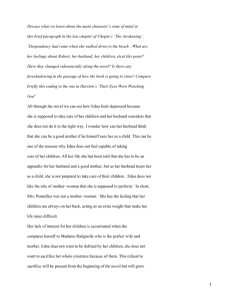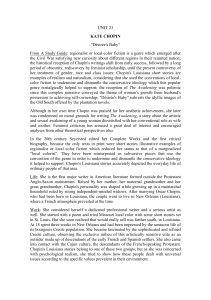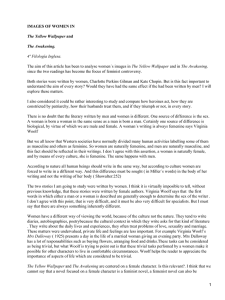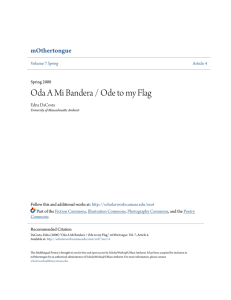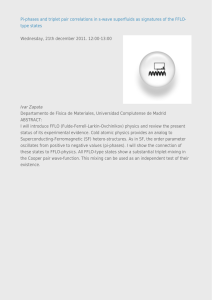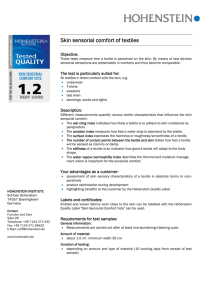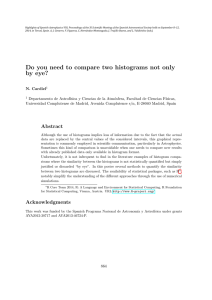Music Evoked Pictures in Her Mind
Anuncio
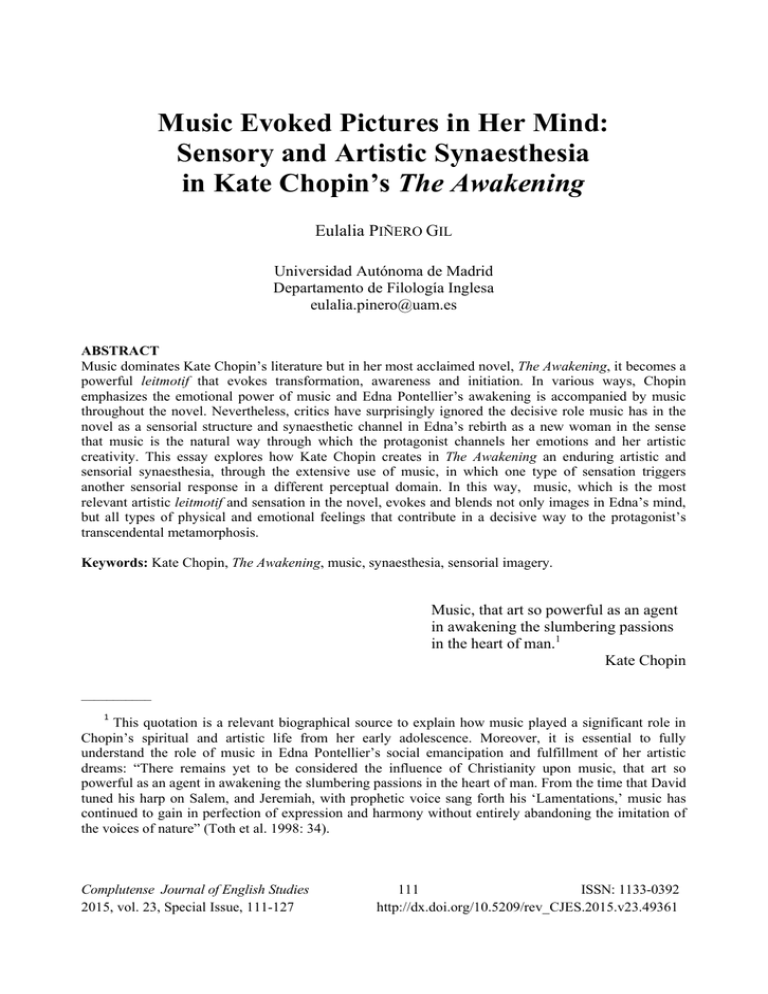
Music Evoked Pictures in Her Mind: Sensory and Artistic Synaesthesia in Kate Chopin’s The Awakening Eulalia PIÑERO GIL Universidad Autónoma de Madrid Departamento de Filología Inglesa [email protected] ABSTRACT Music dominates Kate Chopin’s literature but in her most acclaimed novel, The Awakening, it becomes a powerful leitmotif that evokes transformation, awareness and initiation. In various ways, Chopin emphasizes the emotional power of music and Edna Pontellier’s awakening is accompanied by music throughout the novel. Nevertheless, critics have surprisingly ignored the decisive role music has in the novel as a sensorial structure and synaesthetic channel in Edna’s rebirth as a new woman in the sense that music is the natural way through which the protagonist channels her emotions and her artistic creativity. This essay explores how Kate Chopin creates in The Awakening an enduring artistic and sensorial synaesthesia, through the extensive use of music, in which one type of sensation triggers another sensorial response in a different perceptual domain. In this way, music, which is the most relevant artistic leitmotif and sensation in the novel, evokes and blends not only images in Edna’s mind, but all types of physical and emotional feelings that contribute in a decisive way to the protagonist’s transcendental metamorphosis. Keywords: Kate Chopin, The Awakening, music, synaesthesia, sensorial imagery. Music, that art so powerful as an agent in awakening the slumbering passions in the heart of man.1 Kate Chopin ___________ 1 This quotation is a relevant biographical source to explain how music played a significant role in Chopin’s spiritual and artistic life from her early adolescence. Moreover, it is essential to fully understand the role of music in Edna Pontellier’s social emancipation and fulfillment of her artistic dreams: “There remains yet to be considered the influence of Christianity upon music, that art so powerful as an agent in awakening the slumbering passions in the heart of man. From the time that David tuned his harp on Salem, and Jeremiah, with prophetic voice sang forth his ‘Lamentations,’ music has continued to gain in perfection of expression and harmony without entirely abandoning the imitation of the voices of nature” (Toth et al. 1998: 34). Complutense Journal of English Studies 2015, vol. 23, Special Issue, 111-127 111 ISSN: 1133-0392 http://dx.doi.org/10.5209/rev_CJES.2015.v23.49361 Eulalia Piñero Gil Music Evoked Pictures in Her Mind Music gives soul to the universe, wings to the mind, flight to the imagination and life to everything. Plato Kate Chopin was an insightful observer and listener of American society and culture as her literary corpus illustrates. Particularly, she always showed an outstanding enthusiasm for the popular and classical music of her time in her writings, coteries and in the private sphere of her salon. However, she had a great passion for live music as she performed on the piano the most popular songs and polkas of her city for her family and friends. Moreover, she probably incorporated to her American and European piano repertoire Cajun and Creole music after the period she lived with her husband in New Orleans and Cloutierville in Louisiana (1870-1884). Chopin’s biographers coincide with the fact that music was one of her most cherished devotions together with reading and writing. In fact, music becomes in her fiction the natural way through which many of her American characters communicate their emotions and express their personality. Her most well-known American character, Edna Pontellier, finds in music the best way of communicating her emotional turmoil, her crisis and her awakening to a new personal reality. Thus, The Awakening becomes an invaluable source of the music and sounds that made up the artistic experience of the American middle class and what this social group demanded for performance. Doubtlessly, Chopin was aware of the ephemeral nature of music in her historical period and for that reason she depicts in her most transgressive novel a sort musical landscape of the melodies that were mostly performed on the piano. But what results more striking in The Awakening is how the writer also tries to capture, with her original use of sensorial synaesthesia, the emotional and bodily effects music had on Edna Pontellier, one of her most strikingly rebellious characters. Nearly all critics coincide in stressing the fact that Kate Chopin’s passion for music is represented in a pervasive way in almost all her (Thrailkill 2007, Ellis 1999, Boren 1999, Toth 1999, Showalter 1994) fiction. Nevertheless, the majority of them are unable to draw a clear description of the beginnings, the evolution and the connections of the writer’s inspiration by the muse of music Euterpe and, at the same time, to analyze the sensorial implications of her unique synaesthetic approach in her fiction. Moreover, from my point of view, it is essential to understand how music was the origin of her artistic education that in many ways developed her outstanding talent for the other arts. From a biographical perspective, Kate O’Flaherty was raised as a member of a Franco-Irish upper middle class family in St. Louis. Her gradual awakening to the outside world, to music, literature, and art in general, led her to her own self-realization as well as to a holistic interpretation of the surrounding world. Needless to say, her family background was an asset in this respect as her French great-grandmother, Madame Victoria Verdon Charleville, developed a homemade curriculum in which music played a preeminent role in the young lady’s artistic 112 Complutense Journal of English Studies 2015, vol. 23, Special Issue, 111-127 Eulalia Piñero Gil Music Evoked Pictures in Her Mind education. The young Kate began her piano lessons at age five or six and continued her music training at the Academy if the Sacred Heart in St. Louis and at the Visitation Academy. The curious Kate O’Flaherty had a naturally gifted musical mind because she showed those capacities that are essential for the hearing, the feeling, the understanding and the intuitive interpretation of music. In this sense, her biographer Emily Toth highlights the fact that “when she was an adolescent she could repeat by ear any piece of music she heard” (1999: 13). Besides, St. Louis, her home town, “was one of the country’s most musical cities. Some kind of performance went on every night of the week: philharmonic societies, German bands, touring Italian opera companies, and concerts of every description” (Toth 1999: 46). In fact, when the eighteen year old Kate had the opportunity of attending the concert the famous Norwegian violinist Ole Bull gave in St. Louis in December 1868, she wrote about the mesmerizing effects that breathtaking performance had on her sophisticated perception for melody. The Scandinavian musician played with great virtuoso mastery but the young listener’s ineffable and noetic approach confirmed her unique sensitivity for perceiving an exceptional performance: To describe the effect his music had upon me would be impossible. It seemed the very perfection of the art, and while listening to him, I for the first time longed to be blind, that I might drink it all in undisturbed and undistracted by surrounding objects. I presume I have heard him for the first and last time, as he is now old, and returning to Europe without the intention, I understand, of ever revisiting the United States. (qtd. in Toth et al. 1998: 63-64) This deeply confessional impression is revealing, as it explicitly shows Chopin’s descriptive creativity and how her exceptional aural perception was also linked to an unusual tasting experience: she could drink music. Her verbal depiction speaks of music in terms of taste so she is joining different sensory domains or, in other words, blending auditory with gustatory sensations in an overall synaesthetic experience. But what is more impressive of this vivid description is the young Chopin’s lucid awareness of that extraordinary experience and the ephemeral essence of the musical performance. In an analogous way, Chopin’s main biographer also finds in the writer’s commentary the first significant signs of her involvement with music as a literary creator, because “she was also anticipating Edna Pontellier’s love of music in The Awakening” (Toth 1999: 47). Chopin’s musical education and her participation in the concert life of her home town also developed her artistic talents, and she became not only an exceptional pianist and singer but also a composer; her first publication being “Lilia, Polka” (1888) for piano. Nothing is known about the emotions that inspired the composer to write that polka, other than her daughter's name being Lélia, and the fact that polkas in those days “were quite popular among the Germans and German Americans in St. Complutense Journal of English Studies 2015, vol. 23, Special Issue, 111-127 113 Eulalia Piñero Gil Music Evoked Pictures in Her Mind Louis” (Toth et al. 1998: 195). It seems that H. H. Rollman, the publisher of the piano polka, probably foresaw its market value “and rushed to do business with Kate Chopin” (Toth et al. 1998: 195). Likewise, she was also an opera lover, a consummate Wagnerite, and had the opportunity of attending the best performances at the Saint Louis French Opera House, the first in the United States to stage Richard Wagner’s Lohengrin and Tannhäuser. All this outstanding musical training, performance, knowledge and personal experiences doubtlessly account for Chopin’s need to integrate music within some of her fiction protagonists’ spiritual and artistic growth. Nevertheless, the writer incorporates music in her texts in various different and surprising manners: on the one hand, many of the central characters of her narrations are brilliant music performers as it happens in the case of the pianists Mademoiselle Reisz in The Awakening, and Paula von Stolz in “Wiser Than a God.” These exceptional characters are professional pianists who believe in music as an enriching personal experience and as a social path for women’s social recognition. On the other hand, and as Nancy S. Ellis notes, Chopin’s characters “are influenced and changed by the power of music” (1999: 229). From my point of view, Chopin highlights the ways in which music shapes the lives of many of her protagonists in the private and the public spheres. That is, she depicts in her fiction the transcendental presence of music in nineteenth century American society among the urban middle class people, the rural, the alienated and the underprivileged citizens in short stories such as “At Cheniere Caminada,” “After the Winter,” “A Very Fine Fiddle,” “A Vocation and a Voice,” “Wiser than a God” and “With the Violin.” Yet, what becomes really original and fascinating in her depiction of the musical experience is how some of her characters are physically and psychologically transformed by their sensorial involvement with music which at the same time releases other corporeal responses. Therefore, it becomes not only a powerful sensation but a sort of cognitive path through which other sensory experiences could be enhanced as it happened when the writer attended St. Louis concerts and described the effects of violin music, comparing the hearing of violin melodies with the sensory experience of tasting, as it has been mentioned. Moreover, the young Chopin tasted music when she was listening to it, which is characteristic of a prototypical synasthete’s mind and perception. Thus, for Chopin as well as “for some individuals or synaesthetes, stimulation in one sensory modality may actually give rise to perceptual experience in more than one modality. This remarkable form of perception is labeled synaesthesia” (Sagiv, Dean, and Bailes 2009: 294). There are multiple examples of the relevance of music in Chopin’s life, but her intimate experience with it can also be seen in her private life. For example, in 1896 she was writing a Christmas card for an unnamed acquaintance where she expressed how she could know her better through her piano playing. This revealing short poem is just a pattern that will recur in Chopin’s personal and literary life: how music is a relevant sort of sensorial channel through which she could get a wider holistic 114 Complutense Journal of English Studies 2015, vol. 23, Special Issue, 111-127 Eulalia Piñero Gil Music Evoked Pictures in Her Mind cognitive perception. Therefore, when words failed to express relevant sensorial information, music spoke for her as she could obtain through it a more complete emotional picture of the unknown pianist: To a Lady at the Piano –Mrs. R-n. I do not know you out upon the street Where people meet. We talk as women talk; shall I confess? I know you less! I hear you play, and touched by a wondrous spell I know you well!2 (qtd. in Toth et al. 1998: 193) Kate Chopin experienced life above all as a musician who lived in a world of sound images so realistic that they became part of her emotional experience. Likewise, her cognitive memory was connected with the auditory images which provoked an organic reaction in musical emotion. As previously suggested, music dominates Chopin’s literature as well as her private life. However, in her most acclaimed novel, The Awakening, it becomes a powerful leitmotif that evokes transformation, awareness and initiation. In various ways, the writer emphasizes the emotional power of music and the protagonist Edna Pontellier’s awakening is always accompanied by significant romantic or popular melodies throughout the novel. As it has also been noted, the novelist uses “the musical sounds as an unworded vocal refrain heard at intervals” (Ellis 1999: 224). Though critics have pointed out the significant presence of music in the novel, they have surprisingly ignored its decisive role as a sensory structure and in Edna’s rebirth as a new woman insofar as music is the natural auditory path through which the protagonist channels her emotions and her artistic creativity. Moreover, Edna Pontellier, like Kate Chopin, feels music as a sort of holistic cognitive experience that connects with the rest of the senses. In this light, the German physician and physicist Herman Helmholtz explored in his seminal study On the Sensations of Tone (1954) the preeminence of music among the other arts from a psychological and a physical perspective: Music stands in a much closer connection with pure sensation than any other arts. The latter rather deal with what the senses apprehend, that is the images of outward objects, ___________ 2 This anonymous pianist was probably a source of inspiration for the elderly concert pianist Mademoiselle Reisz. It should be noted that the nameless pianist’s last name begins with R. Complutense Journal of English Studies 2015, vol. 23, Special Issue, 111-127 115 Eulalia Piñero Gil Music Evoked Pictures in Her Mind collected by psychical processes from immediate sensation. In this sense it is clear that music has a more immediate connection with pure sensation that any other of the fine arts, and, consequently, that the theory of the sensations of hearing is destined to play a much more important part in musical esthetics, than for example, the theory of chiaroscuro or of perspective in painting. (1954: 2-3) This description explains how music has significant sensory effects on the body, which Chopin’s adulterous heroine in The Awakening experiments as a physical transformation. Based on the previous evidence it might be concluded that Edna Pontellier, like Kate Chopin, is a complete synaesthete as music evokes vivid visual imagery and other sensory combinations including the tactile, the gustatory and the olfactory. But there are still many other emotional implications for Edna’s artistic and emotional quest as music is in the narrator’s terms “an impress of the abiding truth” (1985: 71) and “music penetrated her whole being like an effulgence, warming and brightening the dark places of her soul” (1985: 135-36). These revealing and meaningful descriptions give us an idea of the ethic and aesthetic dimensions of music in Edna’s life. Thus, Euterpe’s art is much more than pure perception, it signifies creativity, authenticity, inspiration, illumination, connection and many other emotional aspects in the protagonist’s sensorial experience. For her, a stimulus in music immediately triggers a spontaneous consistent response in another sensory modality, having, as a result, strong emotional effects. For that reason, the protagonist is able to see pictures in music, to experience tactile sensations with melodies, the taste of music and, what is more significant, her emotional frame of mind is carried away when she hears her friend and pianist, the free and enigmatic Mademoiselle Reisz, play Frederic Chopin’s piano pieces in the sensual atmosphere of the Grand Isle’s hedonistic soirées: Edna was what she herself called very fond of music. Musical strains, well rendered, had a way of evoking pictures in her mind. […] The very first chords which Mademoiselle Reisz struck upon the piano sent a keen tremor down Mrs. Pontellier’s spinal column. […] But the very passions themselves were aroused within her soul, swaying it, lashing it, as the waves daily beat upon her splendid body. She trembled, she was choking, and the tears blinded her. (1985: 71) The turbulent romantic music of Frederick Chopin’s impromptus, not only draws pictures in Edna’s mind as a visual accompaniment when she hears Madmoiselle’s passionate version, but her very body also becomes part of this synaesthetic experience as it shows her sensorial turmoil: she shivers, she weeps, she is transported to another spiritual and sensorial dimension of understanding and sensuality. In other words, the Polish composer’s music with the free rubato tempo drives Edna into tears because he “mixed sounds as paints are mixed on a palette, and produced colors that had not been imagined before. He opened up new horizons of musical poetry” (1949: x), according to the Polish poet Kazimierz Wierzynski striking synaesthetic 116 Complutense Journal of English Studies 2015, vol. 23, Special Issue, 111-127 Eulalia Piñero Gil Music Evoked Pictures in Her Mind description. Moreover, Edna’s laissez faire, or lack of control over her emotions, reflects the illusion produced by Chopin’s “Fantaisie-Impromptu,” a very popular nineteenth century piano composition intended to produce a fantasy of spontaneous improvisation and emotional agitation: Mademoiselle had glided from the Chopin into the quivering love notes of Isolde’s song, and back again to the Impromptu with its soulful and poignant longing. The shadows deepened in the little room. The music grew strange and fantastic – turbulent, insistent, plaintive and soft with entreaty. The shadows grew deeper. The music filled the room. It floated out upon the night, over the house tops, the crescent of the river, losing itself in the silence of the upper air. Edna was sobbing, just as she had wept one midnight at Grand Isle … (1985: 116) The meaning of Frederick Chopin’s passionate music is so pertinent in the novel that Elaine Showalter has even argued that the structure of the novel mirrors that of the impromptu – “a musical form that seems spontaneous but it is in fact tightly organized” (1994: 176). The all-pervading allusion to other romantic and popular composers such as Franz von Suppé, William Balfe, Eduard Grieg, Ludwig van Beethoven and Richard Wagner, acts as a powerful emotional leitmotif throughout the different scenes of the novel, that is, there is always a suitable music piece for every situation that surrounds Edna Pontellier’s awakening and transformation. However, there is an emphasis on Chopin’s and Wagner’s passionate music because the “writer imagistically mixes romantic desire with inevitable disappointment” (Dyer 1988: 129) to introduce musically Edna’s emotional turmoil and final skepticism about love. Moreover, there is a powerful reason for the striking alternation of both composers’ music: their connection to the romantic synaesthetic tradition, since they believed in this sensorial fusion as an idealistic mechanism, allowing them to perceive more sublime levels of reality. Concretely, Richard Wagner’s “Liebestod,” the love-death song of Tristan and Isolde,3 which is the typemyth of romantic love and its frustration, announces Edna’s romantic suffering, the deep emotional agony in her body for the loss of her beloved Robert Lebrun. Nevertheless, in my view, Chopin’s relevant allusion to one of Wagner’s paradigmatic operas is not coincidental, but the result of her insightful knowledge of the German composer’s aesthetic ideas. She was a convinced Wagnerite who followed the evolution of music theater in her city and discussed the musical impact of the opera composer in the cultural coteries, as Lynda S. Boren has noted (1999: ___________ 3 The writer and journalist Maureen Seaberg alludes to a significant anecdote referring to Richard Wagner’s synaesthetic perception of the music experience when he was rehearsing Tristan and Isolde: “Richard Wagner stormed off during a rehearsal of Tristan and Isolde because in the maestro’s eyes the set’s colors were all wrong; they didn’t match his expectations, given the music he’d written. His royal benefactor agreed and the opera opened with the new set” (2011: 24). Complutense Journal of English Studies 2015, vol. 23, Special Issue, 111-127 117 Eulalia Piñero Gil Music Evoked Pictures in Her Mind 188-89). In particular, the German composer’s holistic vision of a music theatre that represented the drama of classical antiquity, like the Greek classical tragedies that would unite the arts of poetry, music, drama, dance, and scenery in a total performance. Wagnerian opera advocated for a concept of unified art work, “Das Gesamtkuntswerk,” which meant the united, the total experience and the complete synthesis of music with the other arts, and their permanent interaction on stage. This aspect of the composer’s aesthetics is fundamental in order to understand his transformation of nineteenth-century European opera and his crucial contribution to the total renewal of the turn-of-the-century music theater based on his attempt to synthesize romanticism with classicism. The significant echo of Wagner’s music in The Awakening clearly illustrates Chopin’s deep understanding and discussion of the current changes that were taking place in European “Music Theater.” The writer’s transcultural literary dialogue with the aesthetics of the total artwork connects her work to the romantic mystical blending of the arts and its corresponding union with the senses. As a matter of fact, a great number of major musicians, painters and writers of the period were either synaesthetes or were overtly interested in exploring intersensory transfers in their own artistic field: Alexander Scriabin, Richard Wagner, Charles Baudelaire, Arthur Rimbaud, Ludwig Tieck, John Keats, Mme. de Staël, Joris-Kar Huysman, E.T.A Hoffman, Théophile Gautier, Ralph Waldo Emerson, Emily Dickinson, Walt Whitman, and E. A. Poe, among others. In the case of the English Romantic poet John Keats, his poetry is a conspicuous paradigm of synaesthetic imagery in radically different contexts such as in the case of his poem “Isabella; or The Pot of Basil” (1820), in which he explores the protagonist’s madness and death in a decaying Gothic context through the intersensory transfer in the line “And taste the music of that vision pale” (1988: 107), in which he combines taste, sound, and sight together to represent the emotional effects of music in a medieval background of an impossible love. Another representative illustration of this trend in nineteenth-century American verse is Emily Dickinson’s poem “The fascinating chill that music leaves” (1480), which opens with a synaesthetic transfer that connects the auditory with the tactile, having music as the center of the artistic ecstasy and rapture expressed by the poetic voice. The poet of Amherst was an influential reference in synaesthetic imagery as she developed her own original sensory transfers with evocative images such as “A Resonance of Emerald” (1463), “Musicians wrestle everywhere / I hear the silver strife” (157), “What of –my Music! Passive as Granite laps My Music” (261), “They have a little Odor –that to me / Is metre –nay- ‘tis melody” (785). In this context it is crucial to note that artistic synaesthesia also became a romantic ideal among many American Renaissance prose writers. Possibly the literary work that represents the epitome of this aesthetic paradigm is E. A. Poe’s intriguing short story “The Fall of the House of Usher,” where all the arts are represented in a permanent expressive dialogue that is emphasized by Roderick Usher’s sensory hypersensitivity and unstable state of consciousness. Poe’s well-known gothic 118 Complutense Journal of English Studies 2015, vol. 23, Special Issue, 111-127 Eulalia Piñero Gil Music Evoked Pictures in Her Mind character is the literary personification of artistic synaesthesia as he is an exquisite art collector, a talented musician and a seductive poet who expresses his need for mental stability through the permanent interactive fusion of the arts. In fact, romantic poets considered synaesthetes to be the embodiment of spirituality and artistic innovation, but paradoxically synaesthesia was also associated with an ample variety of altered states of consciousness, as in the case of the kaleidoscopic Roderick Usher. Unfortunately, interest in artistic synaesthesia declined for a short period of time in America and Europe as romantic dreams of sensory fusion faded with the emergence of literary realism and the socioeconomic transformation of post war American society. But the coming out of new scientific research on the complex relationships between the human mind and body between 1880 and 1920 brought an innovative way of thinking “in which emotion was increasingly understood to mediate our experience of the exterior world” (Thrailkill 2007: 8). These approaches attempted to solve the intricacies of what the mind is and how it interacts with the body and its emotions, as well as “the connection between cognition (function) and anatomy (structure)” (Harrison 2001: 59). From my perspective, Chopin’s synaesthetic approach was inspired by the scientists’ crucial discoveries in this area in the closing decades of the nineteenth century and by the artists’ contributions in their different creative fields. Shedding some light on the nineteenth-century research on synaesthesia are the experiments of the renowned psychologist G. Stanley Hall, who “in 1883 found that twenty-one of fifty-three children (40%) described musical instrument sounds as colored” (Cytowic and Eagleman 2009: 11). But still, they were far from describing the fundamental mechanisms through which contemporary neuroscience explains empirically how the brain works in terms of its anatomical connections between the different sensory modules and the emotional results of that connectivity. However, the definitive confirmation of the writer’s intuitive and literary synaesthetic connections had to wait almost a century in order to be scientifically explained thanks to the astonishing findings in the late twentieth century by an incredible plethora of neuroscientists (Baron-Cohen and Harrison; Campen; Cytowic; Cytowic and Eagleman; Harrison; Sagiv, Dean, and Bailes). The most recent experiments have provided definitive proof of the neurological existence of synaesthesia. This is the case of Cretien van Campen’s research which proves how the synaesthetes’ brains “show activity in two or more areas of the brain when they hear words and how this activity is absent in nonsynaesthetes” (2010: 5). In the same vein, Cytowic and Eagleman conclude in their study about the brain plasticity and the phenomenology of synaesthesia that “synaesthesia is far more common than originally assumed: one in twenty-three for any type and is even more common among artists” (2009: 8). It is far more likely that Chopin’s representation of sensory and artistic synaesthesia was the visible result of her deep knowledge of the romantic ideals that are represented by her use of the most frequent symbology of this period but, at the Complutense Journal of English Studies 2015, vol. 23, Special Issue, 111-127 119 Eulalia Piñero Gil Music Evoked Pictures in Her Mind same time, her absolute creativity in the re-interpretation of synaesthesia as an original sensorial metaphor. That is undoubtedly what Chopin wanted to achieve with her most acclaimed novel The Awakening: the complete work of art, the novel that represented the transcendental significance of music as the supreme non-narrative and non-discursive mode of expression described by the romantic and symbolist artists. Furthermore, Jane Thrailkill argues that Chopin also references an “influential nineteenth-century debate over the representational status of instrumental or ‘absolute’ music: music detached from any referential context and unaccompanied by the human voice” (2007: 13). In this vein, she also examines how The Awakening “emulates music in its physiological effects on readers” through “the emphasis on repetition, rhythm, and the sound component of language” (2007: 13). All these musical formal analogies are used to transform Edna Pontellier’s body into a sort of “sounding board,” (Thrailkill 2007: 178) accounting for the importance of the links between mind, body, and emotion in the novel, as well as among other realist writers. Thus, the narrative offers a significant display of different arts – painting, poetry, dance, theater, sculpture, architecture, operetta and opera – in a literary context in which music emerges as the most relevant art that in many ways is the interactive path through which the other arts are represented by the writer. There are many instances in the novel, such as Edna’s dinner party, where her friends are inspired by the subtle sound of mandolin music, a delightful accompaniment that arouses her friends’ desire to dance, perform and recite poems in a splendid architectural background. In other words, music not only works as a liberating, inspiring and creative force for Chopin’s characters, but it also becomes a sort of holistic connector that enhances interaction between different arts. One of the guests attending the gathering, Miss Mayblunt, loses her composure when she perceives the highly sensorial scene from a pictorial perspective instead of describing it in a verbal way, “Oh! To be able to paint in color rather than in words!” (1985: 146). It is reasonable to assume that Miss Mayblunt’s professional activity as a writer could allow her to accurately describe with words such an appealing scene, but to many of the characters in the novel, being wordless becomes a habitual experience. This fact can be explained as a consequence of the altered states of consciousness experienced by them. That is, when words cannot express a mode of perception, arts such as music or painting can liberate humans from the prison of language. In the same way, Edna Pontellier is not capable of uttering a word when her friend Mademoiselle Reisz finishes her memorable piano performance, “The young woman was unable to answer; she pressed the hand of the pianist convulsively, Mademoiselle Reisz perceived her agitation and even her tears” (1985: 72). The protagonist’s extreme sensitivity enables her to reveal the artistic accomplishment of her pianist friend and as a consequence she can only express her emotional turmoil in a tactile way, a factual reality that emphasizes the failure of language to express the complexity of her perceptual experiences. In a similar way, the extraordinary pianist voices Chopin’s 120 Complutense Journal of English Studies 2015, vol. 23, Special Issue, 111-127 Eulalia Piñero Gil Music Evoked Pictures in Her Mind own thoughts toward music and how it was a creative path to transcend cultural limitations. Another case in point of how music is the main stimulus in Edna´s various sensory domains is when she becomes the performer of her own music, that is, when she sings a melody that brings back her recollections of an unforgettable recent past. This revealing moment of musical and painting introspection unchains a holistic sensorial response that encompasses all senses: Edna perceived that the young women’s back and shoulders were molded on classic lines, and that her hair, loosened from its confining cap, became an inspiration. While Edna worked she sometimes sang low the little air, “Ah! Si tu savais!” It moved her with recollections. She could hear the ripple of the water. The flapping sail. She could see the glint of the moon upon the bay, and could feel the soft, gusty beating of the south wind. A subtle current of desire passed through her body, weakening her hold upon the brushes and making her eyes burn. […] She was happy to be alive and breathing, when her whole being seemed to be one with the sunlight, the color, the odors, the luxuriant warmth of some perfect Southern day. (1985: 109) Music moves Edna and induces her to new feelings, moods, states of mind and spiritual vision. Besides, the evocative power of music is connected to her synaesthetic capacities. The regular tempo and rhythm of music is therapeutic for Edna, who finds in her own melody singing responses to her quest for emotional stability even though there are certain moments in which she loses equanimity, as it happens when she reads Robert Lebrun’s letters: “Edna did not at once read the letter. She sat holding it in her hand, while the music penetrated her whole being like effulgence, warming and brightening the dark places of her soul. It prepared her for joy and exultation” (1985: 135-136). The main character of The Awakening experiences reality in as many forms as possible and sensory synaesthesia reinforces her emotional qualities. Under the artistic influence of Mademoiselle Reisz’s virtuoso playing, Edna finds the proper inspiration not only to sing but also to initiate her quest for artistic achievement. In doing so, she also decides to take up painting as a means to develop her creativity and independence. In fact, she begins her new life as a portrait painter of her friends and family. But above all she becomes a woman painter of her own desires and social expectations, insofar as she aspires to become an independent woman artist. As a matter of fact, at the beginning Edna finds in painting, as well as in music, a source of amusing gratification: “Mrs. Pontellier had brought her sketching materials, which she sometimes dabbled with in an unprofessional way. She liked the dabbling. She felt in it satisfaction of a kind which no other employment afforded her” (1985: 55). But as it becomes more than pure improvisation, her painting experiments a stylistic evolution to impressionism that is part of her artistic emancipation. Likewise, Kate Chopin also found in the French impressionistic school of painting her inspiration in Complutense Journal of English Studies 2015, vol. 23, Special Issue, 111-127 121 Eulalia Piñero Gil Music Evoked Pictures in Her Mind the vivid color and bold brushstrokes to create overall images. From a stylistic point of view, the influence of that fin de siècle school of painting can also be appreciated, both in the descriptions of the refined party dresses worn by Edna and her friend Madame Ratignole and in the coastland of the Gulf of Mexico. Nevertheless, what really becomes more amazing is Edna’s capacity to translate her impressions of nature, her memories, and her reactions to music into “pictures”: First of all, the sight of the water stretching so far away, those motionless sails against the blue sky, made a delicious picture that I just wanted to sit and look at. The hot wind beating in my face made me think – without any connection that I can trace – of a summer day in Kentucky, of a meadow that seemed as big as the ocean to the very little girl walking through the grass, which was higher that her waist. She threw out her arms as if swimming when she walked, beating the tall grass as one strikes out in the water. Oh, I see the connection now! (1985: 60) The former quotation is a relevant example of the complex web of synaesthetic relations perceived by Edna’s intense approach to reality: she describes the picture with the sense of tasting and the vision of the landscape results in “a delicious picture.” In other words, not only does she see or feel music or painting but also tastes them all as well. Moreover, her extremely complex sensory synaesthesia permits her to transfer between two intimate and distant experiences: her adult’s vision of the sea and her childhood’s feeling of a Kentucky meadow. Edna ends up knowing and visualizing the connection as she is able to move from the sense of sight to the sense of touching and this is how a Kentucky meadow becomes a warm sea where she swims. That is, her entire body is transported from the real watery imagery to the unreal sea of grass. This is the process through which an apparently basic perception may trigger a complex synaesthetic process in the brain. Similarly, Edna associates the race horse with her childhood, but in this case her amazing olfactory memory has again a huge evocative power, “The atmosphere of the stables and the breath of the blue grass paddock revived in her memory and lingered in her nostrils” (1985: 128). In this way, The Awakening connects sounds, smells, colors, and visual images in a permanent transfer between two different contexts, producing synaesthesia as a form of metaphor. There are numerous instances in which Edna’s feelings are described in terms of visual, sound and tactile sensations, like when the narrator alludes to her passionless marriage, “no trace of passion or excessive and fictitious warmth colored her affection, thereby threatening its dissolution” (1985: 63). Edna’s resigned acceptance of a conventional marital relationship possesses a lack of enthusiasm and desire that is the paradigm of a dead marriage syndrome even though she has been married for six years. In opposition to the indifference she shows towards Leónce Pontellier, her beloved’s melodious voice reverberates in her mind and “it was musical and true. The voice, the notes, the whole refrain haunted her memory” (1985: 89). But Robert 122 Complutense Journal of English Studies 2015, vol. 23, Special Issue, 111-127 Eulalia Piñero Gil Music Evoked Pictures in Her Mind Lebrun’s departure transforms the sweet echoes of his voice into unpleasant color and sound images: Robert’s going had some way taken the brightness, the color, the meaning out everything. The conditions of her life were in no way changed, but her whole existence was dulled, like a faded garment which seems to be no longer worth wearing. […] She went up in the mornings to Madame Lebrun’s room, braving the clatter of the old sewing-machine. (1985: 95) In this particular moment of the novel, the narrator compares Edna’s unhappiness, using images that contribute to create the illusion of a colorless picture reinforced by another visual object “faded garment,” that will be reinterpreted later as “pricking garments” (1985: 175) that she takes off in her last embrace with the sensuous sea. The sensorial contrast is achieved when the reader is introduced to the disagreeable sound of Madame Lebrun’s sewing-machine that was previously represented and repeated, up to eight times, in chapter VIII, “Clatter, clatter, bang, clatter!” (1985: 67).The reminder effect of the insistent onomatopoetic reverberation remains in the reader, immediately recalling the unpleasant and strident sound effect. The powerful combination of this aural technique with the pictorial images clearly illustrates Chopin’s method that brings together the elements of sound, hearing and touching into her original approach to create sensorial atmospheres. The implications of this versatile manner of apprehending the sensorial world allows Edna to assimilate differing sensations into a holistic, visionary, and complex perceptive system that makes her an extraordinarily unique character in the history of American literature. But what is more transcendental is that this holistic approach definitively affects the reader’s/listener’s recreation of the character in the sense that Edna’s unified sensory experience reflects her exceptional and complex way of facing her personal crisis and various awakenings during her prolific summer at Grand Isle, that is, her strong introspective willing to pursue a global transformation of her mind and body. The result of this singular cognitive process is that Chopin shows an authorial consistence in the sense that her most accomplished character is the outcome of a perfect correspondence between her desires and her ways of approaching the challenging circumstances that surrounds her. For this purpose, Edna swims in a sea of synaesthetic imagery that reveals her joined perception and her holistic enjoyment of art and life. In all the examples of sensorial synaesthesia which have been analyzed so far, there are certain common perceptual aspects that systematically elude conceptual language insofar as they speak of vision in terms of music, of music in terms of taste, and of vision in terms of touching, feeling, and smelling. It is reasonable to assume that Kate Chopin elaborated on the use of aural, visual, and other sensory images in The Awakening as a means of successfully creating a poetical effect based on Complutense Journal of English Studies 2015, vol. 23, Special Issue, 111-127 123 Eulalia Piñero Gil Music Evoked Pictures in Her Mind synaesthetic metaphoric transfers on a text whose apparent simplicity does not impede what I call “a sensorial universe of great beauty and refinement” (Piñero Gil 2013: 91-92). Nevertheless, in Edna’s life not all her close friends and relatives really appreciate her unique synaesthetic experiences. Even though she finds in music and painting a liberating and inspiring artistic path, her husband, Léonce Pontellier, has no interest whatsoever in music. In fact, he had no musical training, no comprehension apart from his interest in speculative business, but what was more revealing is the fact that he had no curiosity for her wife’s sensorial and spiritual evolution. This is just an evidence of the couple’s detachment and unresolved marital conflict: Mr. Pontellier did not attend these soirées musicales. He considered them bourgeois, and found more diversion at the club. To Madame Ratignolle he said the music dispensed at her soirées was too “heavy,” too far beyond his untrained comprehension. His excuse flattered her. But she disapproved of Mr. Pontellier’s club, and she was frank enough to tell Edna so. (1985: 121) The narrator uses de adjective “heavy” to describe Mr. Pontellier’s lack of interest and his unpleasant and tedious physical perception of these particular musical experiences. It goes without saying that Chopin’s description moves from the abstract experience of music to a concrete depiction of the physical effects these soirées musicales provoke in Edna’s husband. Once again, this is a clear example of how music or the aural stimulus in one modality is experienced with sensations more associated with a second modality such as forms of feeling or touching. In my view, this case illustrates how Chopin uses an incredible number of adjectives referring to sensorial experience in which there is a synaesthetic metaphoric transfer. The last episode of Edna Pontellier’s final celebration of her new life, her evening dinner party, is her own personal hedonistic climax, on her twenty-ninth birthday at her luxurious marital mansion in New Orleans. The table is “extremely gorgeous” (1985: 142-43) and she wears a “cluster of diamonds that sparkled, that almost sputtered, in her hair” (1985: 143). The atmosphere of wine, fragrant roses, and color is a feast for the senses, a ceremony of artistic and sensorial synaesthesia, as there is “the occasional sound of music of mandolin” (1985: 145), gorgeous clothes, exquisite food, theater, poetry, and dancing. Needless to say, Edna celebrates her transformation with all her friends to show them that from that moment onwards she will abandon her bourgeois life and begin her own independent and artistic existence. This exceptional coup d’état, as her lover Arobin titles the event, is just a social and sensual rite of passage that inaugurates her personal transformation and, at the same time, represents an unambiguous turning point. It remains to say that the ending of the novel reaffirms once again Edna’s predominant belonging to the realm of music and sounds: she goes back to nature, to the resonant waters of the Gulf because: “the voice of the sea is seductive, never ceasing, whispering, clamoring, murmuring, inviting the soul to wander in abysses of 124 Complutense Journal of English Studies 2015, vol. 23, Special Issue, 111-127 Eulalia Piñero Gil Music Evoked Pictures in Her Mind solitude” (1985: 175). Her last spiritual watery rebirth is a sort of sensual celebration and discovery of her naked body with the sea: “The touch of the sea is sensuous, enfolding the body in its soft, close embrace” (1985: 176). In this romantic way, Edna swims back into the sensory experiences of her youth where the sounds of her sister’s and father’s voices predominate, but there were also “the hum of bees, and the musky odor of pinks filled the air” (1985: 176). In her final encounter with the natural rhythmic sounds of the sea, the scent and colors of pinks or Dianthus flowers (from the Greek “dios,” god, and “anthos,” flower) that were used in Greece to crown heroes, clearly symbolize Edna’s fearless and cathartic bath in the ocean with the allusive pagan divine image of “Venus rising from the foam” (1985: 173) of despair, solitude, and spiritual nakedness. Moreover, it is the ultimate heroic confirmation of her earlier transgressive decision “to swim far out, where no woman had swum before” (1985: 73). As Lynda Boren concludes, “Edna drowns in a sea of sensations … and the predominant one, the sensation of sound overwhelms her” (1999: 181). Once more, Chopin’s most controversial heroine decides to reaffirm her Emersonian early ideals of freedom and self-reliance surrounded by the sensorial world of natural sounds, colors, fragrances, and feelings. As has been shown in this interdisciplinary analysis of The Awakening, Chopin provides in her novel a very complete and detailed description of the social and affective roles of music in the nineteenth-century American middle-class. Piano concerts were very popular in the private parlors and musical soirées were arranged so that the amateur or professional pianists could perform the American and European repertoires. Chopin also tries to capture in her novel the bodily effects music had on her American heroine Edna Pontellier through an enduring and multiple sensory synaesthesia in her novel, through the extensive predominant use of music and sounds. Thus, music, the most powerful artistic leitmotif and sensation in the narrative, evokes and blends not only images in Edna Pontellier’s mind, but all types of physical and emotional sensations that contribute, in a decisive way, to her transcendental metamorphosis. Finally, Edna’s quest for a new transgressive and independent artistic self is linked to music since, in my view, it is the most relevant cognitive synaesthetic channel through which other senses and arts, such as painting, poetry, dance, theater, sculpture, architecture, operetta, and opera, are explored in order to reach the protagonist’s enduring holistic transformation.4 ___________ 4 This research is dedicated to the friendship and memory of Pepa Feu, who inspired me with her amazing creativity. Her belief in music as the origin of language and as an essential part of human cognitive development encouraged me to explore literature from this enriching interdisciplinary approach. Complutense Journal of English Studies 2015, vol. 23, Special Issue, 111-127 125 Eulalia Piñero Gil Music Evoked Pictures in Her Mind REFERENCES Baron-Cohen, Simon, and John E. Harrison, eds. (1997). Synaesthesia: Classic and Contemporary Readings. London: Wiley-Blackwell. Boreham, Judy, and Heath Duncan (2005). Synaesthesia: The Unified Art Work. Cambridge: Totem Books. Boren, Lynda S. (1999). Taming the Sirens: Self-Possession and the Strategies of Art in Kate Chopin’s The Awakening. In Boren, Lynda S. and Sara deSaussure Davis, eds., 180-196. Boren, Lynda S., and Sara deSaussure Davis, eds. (1999). Kate Chopin Reconsidered. Beyond the Bayou. Baton Rouge: Louisiana State UP. Campen, Cretien van (2010). The Hidden Sense: Synesthesia in Art and Science. Cambridge: MIT P. Chopin, Kate (1985). The Awakening and Selected Stories. Harmondsworth: Penguin. Chopin, Kate (2013). El despertar. Trans. and ed. Eulalia Piñero Gil. Madrid: Cátedra. Cytowic, Richard E. (2002). Synesthesia: A Union of the Senses. Cambridge: MIT P. Cytowic, Richard E. (2003). The Man Who Tasted Shapes. Cambridge: MIT P. Cytowic, Richard E., and David Eagleman (2009). Wednesday is Indigo Blue. Discovering the Brain of Synesthesia. Cambridge: MIT P. Dean, R. T. ed. (2009). The Oxford Handbook of Computer Music. New York: Oxford UP. Dickinson, Emily (1975). The Complete Poems. London: Faber & Faber. Dyer, Joyce (1988). Symbolism in the Awakening. In Koloski, Bernard, ed., 126-131. Ellis, Nancy S. (1999). Insistent Refrains and Self-discovery: Accompanied Awakenings in Three Stories by Kate Chopin. In Boren, Lynda S. and Sara deSaussure Davis, eds., 216-229. Harrison, John E (2001). Synaesthesia. The Strangest Thing. Oxford: Oxford UP. Helmholtz, Hermann (1954). On the Sensations of Tones. New York: Dover. Keats, John (1988). Selected Poems. London: Penguin. Koloski, Bernard, ed. (1988). Approaches to Teaching Chopin’s The Awakening. New York: Modern Language Association of America. Piñero Gil, Eulalia (2013). Introducción. In Chopin, Kate (2013), 9-123. Sagiv, Noam, R. T. Dean, and F. Bailes (2009). Algorithmic Synesthesia. In Dean, R. T., ed., 294-311. Seaberg, Maureen (2011). Tasting the Universe: People Who See Colors in Words and Rainbows in Symphonies. Pompton Plains, NJ: New Page Books. Showalter, Elaine (1994). The Awakening: Tradition and the American Female Talent. Sister’s Choice. Tradition and the Change in American Women’s Writings. Oxford: Oxford UP, 65-84. Thrailkill, Jane F. (2007). Affecting Fictions. Mind, Body, and Emotion in American Literary Realism. Cambridge: Harvard UP. Toth, Emily (1999). Unveiling Kate Chopin. Jackson: UP of Mississippi. 126 Complutense Journal of English Studies 2015, vol. 23, Special Issue, 111-127 Eulalia Piñero Gil Music Evoked Pictures in Her Mind Toth, Emily, Per Seyersted, and Cheyenne Bonnell, eds. (1998). Kate Chopin’s Private Papers. Bloomington: Indiana UP. Wierzynski, Kazimierz (1949). The Life and Death of Chopin. New York: Simon and Schuster. Complutense Journal of English Studies 2015, vol. 23, Special Issue, 111-127 127
